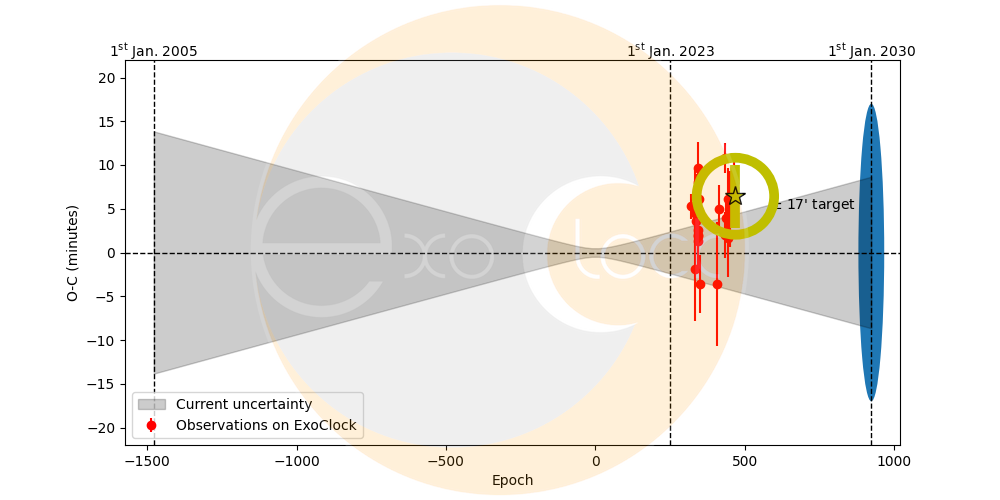Contribution by Dr. Gerold Holtkamp, June 2025
The measurements were taken from 7:26 p.m. UTC on April 7, 2025, to 12:51 a.m. UTC on April 8, 2025, in Osnabrück, Sonnenhügel. The moon was 78% illuminated and 66° distant. It set at 3:24 a.m. UTC on April 8, 2025, and was therefore visible throughout the entire measurement period. It could therefore have shone into the telescope and potentially influenced the measurement accuracy.
The measurement technique used:
Telescope: Skywatcher Newton 250/1200 mm
Mount: Skywatcher AZ-EQ6
Filter: Luminanz (Antlia)
Camera: QHY268M with gain 60, offset 20, chip temperature -10° C
Guiding: Skywatcher Guidescope Evoguide 50 ED with camera ZWO ASI120mm
NINA was used for camera and mount control.

The present measurement and the subsequent evaluation with the hops software of the Exoclock-Project resulted in:
Rp/Rs = 0.086 +/- 0.0047 (expected 0.0865 +/- 0.0008) *
-> Rp = 0.086 x 1,001,337 = 86,115 +/- 4,707 km. [1]
The exoplanet TOI-4137b is thus slightly larger than Jupiter (radius = 69,911 km). The slight dip in the transit light curve is due to the large parent star. The system is 1,093 light-years from Earth. There is another measurement by the author from March 19, 2025. The measurement curve is similarly noisy, but the result agrees within the margin of error.

The value of the transit's temporal center, which is important for the Exoclock project and is expressed as the difference between the observed and expected values, deviates significantly from the expected value at O-C = -6.43 +/- 3.6 minutes**. However, most of the available values from other authors show similarly large positive deviations. It remains to be seen what further measurements will reveal.
The measurement of the transit light curve of the exoplanet Qatar-1b was published on the Exoclock project website. [2]
There is another measurement by the author on this website. [3]
__________________________________________________________________
* [Rp = Rplanet, Rs = Rstar]
If the star's radius is known, the planet's radius is determined directly from the dip in the light curve. (see also https://kosmos-os.de/messung-der-transitlichtkurven-der-exoplaneten-wasp-84b-und-kps-1b-am-7-und-8-maerz-2024)
** [O = Observed, C = Calculated]
[1]
Data on the star system and the exoplanet at
https://exoplanetarchive.ipac.caltech.edu/overview/TOI-4137
The radius of the parent star was taken as 1.438 +0.039/-0.038 (Yee et al. 2022) x the radius of the Sun. The radius of the Sun was assumed to be 696,340 km. The parent star thus has a radius of 1,001,337 km.
[2]
https://www.exoclock.space/database/observations/TOI-4137b_2427_2025-04-07_Gerold_1561_Lum/
[3]
https://kosmos-os.de/messung-der-transitlichtkurve-des-exoplaneten-toi-4137b-am-19-20-maerz-2025